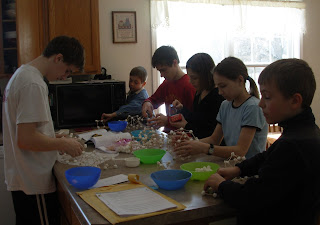One Train, Many Stations
One strategy for schooling a wide range of children is to use unit studies for history, science and/or other subjects which could include Bible, literature, and art. The beauty of a unit-study approach with children of various grades is that everyone can learn about the same general themes on his own level. Sometimes we don’t all use the same curricula, but still tackle the same or similar subject areas. For example, a high school student might be studying biology while the younger ones spend the year emphasizing a few areas of life science such as animals, the human body, and plants. Focusing on the same or similar areas allows your family to have great dinner discussions about their discoveries, and brings more cohesion to your homeschool. As my children reach high school, their specific course requirements don’t always allow for this meshing, but to simplify my life I look for connections whenever possible.
This year, happily, it did work out for even my high schoolers to join us in our study of Medieval and Renaissance/Reformation history using Tapestry of Grace. Unlike some unit studies which begin with the younger children and then try to beef it up for teens, Tapestry of Grace was designed first with the needs of older students in mind, and then the authors figured out how to fit younger ones into the plan. Kristen is even taking an art history class at Purdue, beginning from the Renaissance, our current history period, so we’ve had some fun conversations with her as we were looking at many of the same works.
My older boys will be earning one credit (equivalent to one semester, though we are spreading it out over the full year) for art, a combination of studio art and art appreciation. Their art appreciation program combines visual arts (painting and sculpture), architecture, and a bit of music. Friday afternoons we spend an extended time doing art and projects. We often start our time together, then divide up for age-appropriate explorations. It’s like being on the same train, but each student gets off at a different station. Here’s how it worked last Friday with a Leonardo da Vinci theme:
We began with a fun activity from Amazing Leonardo da Vinci Inventions You Can Build Yourself. First we read how Leonardo worked with the mathematician Luca Pacioli, making connections between math and art, and illustrating 3-D polygons in a way never done before by showing polygons with open faces so you can see through them. We then built our own open-faced octahedrons (8 –faced figure), icosohedron (20 faces) and rhombicuboctahedron (26 faces) from marshmallows and toothpicks. After we’d completed that, I sent the big boys off to watch a Teaching Company DVD on Platonic solids. (It was one of my review products for my job as reviewer for Practical Homeschooling Magazine.) The lecture showed how there are only five regular “Platonic” solids, and how each one has a dual image which is either another Platonic solid or itself. (It’s easier to see than to describe in words, but it is kind of cool, especially after playing around with our own polyhedrons.)
 At the same time I sent my girls to another room where they used a Phonics of Drawing DVD (another review product from some years ago) to do a portrait drawing lesson. They learned how to “map” a face, and their pictures are lovely. I worked with Ben and Paul, reading more in the Leonardo Inventions book, learning how the master loved to play pranks on his friends, including using invisible ink. They then tried writing with: a) baking soda and water and b) milk. When their papers dried, we made the writing appear by: a) painting over with cooking wine (grape juice will do) and b) heating the paper in the oven for a few minutes. Both ways worked reasonably well.
At the same time I sent my girls to another room where they used a Phonics of Drawing DVD (another review product from some years ago) to do a portrait drawing lesson. They learned how to “map” a face, and their pictures are lovely. I worked with Ben and Paul, reading more in the Leonardo Inventions book, learning how the master loved to play pranks on his friends, including using invisible ink. They then tried writing with: a) baking soda and water and b) milk. When their papers dried, we made the writing appear by: a) painting over with cooking wine (grape juice will do) and b) heating the paper in the oven for a few minutes. Both ways worked reasonably well.The reason I’ve described our activities is not so you can do these exact projects, but just to demonstrate how this unit study/ train model can work. As long as all your children are elementary ages, you can usually keep them together pretty easily. But as they get beyond grade school, their academic needs grow beyond the little ones. Still, it pays to try to brainstorm those areas you might work on with the same theme, but with different goals/resources/projects, etc. Start off together, split up for further exploration, then come back together later (maybe during dinner) and talk about what everyone learned. One of the wonderful things about homeschooling is how it builds family bonds. When we just send older kids off to work independently for all their subjects, we lose some of this. Maximize family cohesiveness (and minimize the directions your brain needs to run) by having everyone work in the same direction whenever possible!




Comments
I'm glad it was helpful. There are some fabulous unit study curricula out there which can provide great direction, so don't worry that you have to invent everything yourself. Are there particular programs you are looking at? Hope you are all well!
- Anne